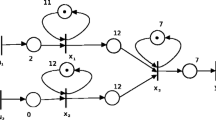Abstract
Timed Event Graphs (TEGs) are a specific class of Petri nets that have been thoroughly studied given their useful linear state representation in (Max,+) algebra. Unfortunately, TEGs are generally not suitable for modeling systems displaying resources sharing (or conflicts). In this paper, we show that if a system with conflicts is modeled using a NCTEG (Networked Conflicting Timed Event Graphs), it is quite possible to obtain an equivalent (Max,+) representation. More precisely, we prove that the evolution of a NCTEG satisfies linear time-varying (Max,+) equations. In case of cyclic NCTEGs, which are a natural model of many repetitive systems, we provide a standard time-invariant (Max,+) representation. As an application of the proposed approach to exhibit its interest, we consider the case of Jobshops. We first propose a generic NCTEG-based model of these systems and subsequently apply the corresponding (Max,+) representation to evaluate some of their performances.






Similar content being viewed by others
References
Addad B, Amari S, Lesage JJ (2010) Linear time-varying (Max,+) representation of conflicting timed event graphs. In: 10th int. workshop on discrete event systems, Berlin, Germany, pp 310–315
Baccelli F, Cohen G, Olsder GJ, Quadrat JP (1992) Synchronization and linearity: an algebra for discrete event systems. Wiley, New York
Baccelli F, Foss S, Gaujal B (1996) Free choice Petri nets: an algebraic approach. IEEE Trans Automat Contr 41(12):1751–1778
Bolzern P, Colaneri P, Scatolini R (1986) Zeros of discrete time linear periodic systems. IEEE Trans Automat Contr 31:1057–1058
Boutin O, Cottenceau B, L’Anton A, Loiseau JJ (2009) Modeling systems with periodic routing functions in dioid (Min,+). In: 13th IFAC symposium on information control problems in manufacturing, Moscow, Russia, pp 1377–1382
Cohen G, Gaubert S, Quadrat JP (1999) Max plus algebra and systems theory: where we are and where to go now. Annu Rev Control 23:207–219
Correia A, Abbas-Turki A, Bouyekhf R, El Moudni A (2009) A dioid model for invariant resource sharing problems. IEEE Trans Syst Man Cybern Part A Syst Humans 39(4):770–781
Gaubert S (1995) Resource optimization and (min,+) spectral theory. IEEE Trans Automat Contr 40(11):1931–1934
Gaubert S, Mairesse J (1999) Modeling and analysis of timed Petri nets using heaps of pieces. IEEE Trans Automat Contr 44(4):683–697
Hillion H, Proth JM (1989) Performance evaluation of jobshop systems using timed event graphs. IEEE Trans Automat Contr 34(1):3–9
Laftit S, Proth JM, Xie XL (1992) Optimization of invariant criteria for event graphs. IEEE Trans Automat Contr 37(6):547–555
Lahaye S, Boimond JL, Hardouin L (2004) Linear periodic systems over dioids. Discrete Event Dyn Syst 14(2):133–152
Litvinov GL, Sobolevski AN (2001) Idempotent interval analysis andoptimization problems. Reliab Comput (Kluwer) 7(5):353–377
Mayer E, Haus U-U, Raisch J, Weismantel R (2008) Throughput-optimal sequences for cyclically operated plants. Discrete Event Dyn Syst 18(3):355–383
Misra P (1996) Time-Invariant representation of discrete periodic systems. Automatica 32(2):267–272
Murata T (1989) Petri nets: properties analysis and applications. Proc IEEE 77(4):541–580
Nait SM, Manier MA, El Moudni A, Wack M (2006) Petri net with conflicts and (max,plus) algebra for transportation systems. In: 11th IFAC symposium on transportation systems, The Netherlands
Van Den Boom TJJ, De Shutter B (2006) Modeling and control of discrete event systems using switching Max-Plus linear systems. Control Eng Pract 14(10):1199–1211
Author information
Authors and Affiliations
Corresponding author
Appendix
Appendix
Rights and permissions
About this article
Cite this article
Addad, B., Amari, S. & Lesage, JJ. Networked conflicting timed event graphs representation in (Max,+) algebra. Discrete Event Dyn Syst 22, 429–449 (2012). https://doi.org/10.1007/s10626-012-0136-0
Received:
Accepted:
Published:
Issue Date:
DOI: https://doi.org/10.1007/s10626-012-0136-0




